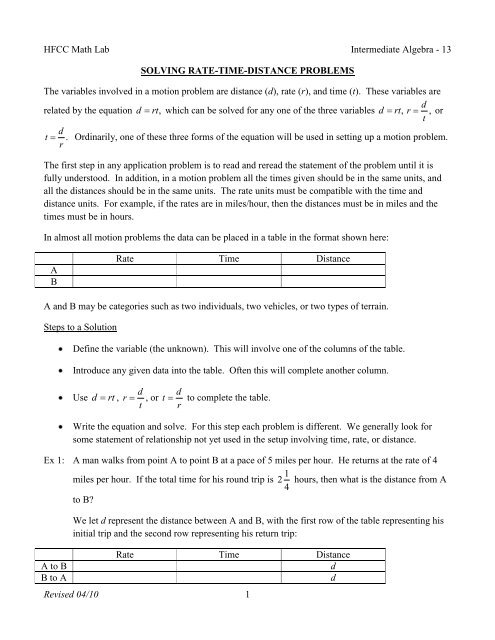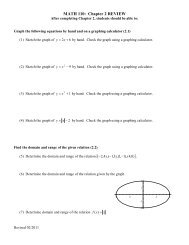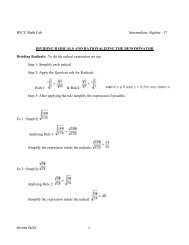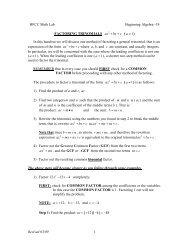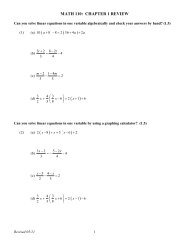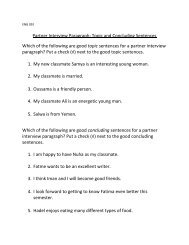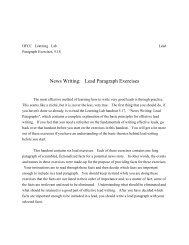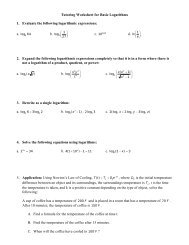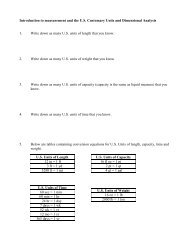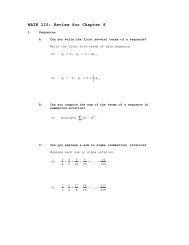Solving Rate-Time-Distance Problems - The Learning Lab at HFCC
Solving Rate-Time-Distance Problems - The Learning Lab at HFCC
Solving Rate-Time-Distance Problems - The Learning Lab at HFCC
- No tags were found...
You also want an ePaper? Increase the reach of your titles
YUMPU automatically turns print PDFs into web optimized ePapers that Google loves.
<strong>HFCC</strong> M<strong>at</strong>h <strong>Lab</strong> Intermedi<strong>at</strong>e Algebra - 13SOLVING RATE-TIME-DISTANCE PROBLEMS<strong>The</strong> variables involved in a motion problem are distance (d), r<strong>at</strong>e (r), and time (t). <strong>The</strong>se variables aredrel<strong>at</strong>ed by the equ<strong>at</strong>ion d rt , which can be solved for any one of the three variables d rt , r , ortdt . Ordinarily, one of these three forms of the equ<strong>at</strong>ion will be used in setting up a motion problem.r<strong>The</strong> first step in any applic<strong>at</strong>ion problem is to read and reread the st<strong>at</strong>ement of the problem until it isfully understood. In addition, in a motion problem all the times given should be in the same units, andall the distances should be in the same units. <strong>The</strong> r<strong>at</strong>e units must be comp<strong>at</strong>ible with the time anddistance units. For example, if the r<strong>at</strong>es are in miles/hour, then the distances must be in miles and thetimes must be in hours.In almost all motion problems the d<strong>at</strong>a can be placed in a table in the form<strong>at</strong> shown here:AB<strong>R<strong>at</strong>e</strong> <strong>Time</strong> <strong>Distance</strong>A and B may be c<strong>at</strong>egories such as two individuals, two vehicles, or two types of terrain.Steps to a SolutionDefine the variable (the unknown). This will involve one of the columns of the table.Introduce any given d<strong>at</strong>a into the table. Often this will complete another column.Use d rt ,rdt , ortdrto complete the table.Write the equ<strong>at</strong>ion and solve. For this step each problem is different. We generally look forsome st<strong>at</strong>ement of rel<strong>at</strong>ionship not yet used in the setup involving time, r<strong>at</strong>e, or distance.Ex 1: A man walks from point A to point B <strong>at</strong> a pace of 5 miles per hour. He returns <strong>at</strong> the r<strong>at</strong>e of 41miles per hour. If the total time for his round trip is 2 hours, then wh<strong>at</strong> is the distance from A4A to BB to Ato B?We let d represent the distance between A and B, with the first row of the table representing hisinitial trip and the second row representing his return trip:<strong>R<strong>at</strong>e</strong> <strong>Time</strong> <strong>Distance</strong>ddRevised 04/10 1
We now introduce the given d<strong>at</strong>a. We are given both r<strong>at</strong>es. (We omit the units, which arecomp<strong>at</strong>ible, from the table.)<strong>R<strong>at</strong>e</strong> <strong>Time</strong> <strong>Distance</strong>A to B 5 dB to A 4 dSincetdr, we now complete the table.<strong>R<strong>at</strong>e</strong> <strong>Time</strong> <strong>Distance</strong>A to B 5d5dB to A 4d4dWe now write an equ<strong>at</strong>ion. In this case the equ<strong>at</strong>ion comes from the st<strong>at</strong>ement in the problem1 9th<strong>at</strong> the total time is 2 hours. Thus we have4 4(time from A to B) + (time from B to A) = 9 4d d 95 4 44d 5d 45(Multiply each side by the LCD, 20.)9d45d5<strong>The</strong> distance between the points is thus 5 miles.Ex 2: Two planes leave an airport <strong>at</strong> the same time and travel in opposite directions. If one planeaverages 440 miles per hour and the other 560 miles per hour, then in how long will the planesbe 2500 miles apart?We let t be the time of travel, since th<strong>at</strong> is wh<strong>at</strong> we are trying to find. Each row represents ther<strong>at</strong>e, time, and distance of one of the planes.<strong>R<strong>at</strong>e</strong> <strong>Time</strong> <strong>Distance</strong>Plane 1tRevised 04/10 2
Plane 2t<strong>The</strong> r<strong>at</strong>es are given, so we enter those into the table:<strong>R<strong>at</strong>e</strong> <strong>Time</strong> <strong>Distance</strong>Plane 1 440 tPlane 2 560 tWe use the rel<strong>at</strong>ion drt to complete the table:<strong>R<strong>at</strong>e</strong> <strong>Time</strong> <strong>Distance</strong>Plane 1 440 t 440tPlane 2 560 t 560t<strong>The</strong> equ<strong>at</strong>ion comes from the fact th<strong>at</strong> when the planes are 2500 miles apart, the distancestraveled by the planes will total 2500 miles:440t 560t2500t2.5<strong>The</strong> time required is thus 2.5 hours.Ex 3: Two planes leave an airport <strong>at</strong> the same time and travel in the same direction. If one planeaverages 440 miles per hour and the other 560 miles per hour, then in how long will the planesbe 2500 miles apart?We note th<strong>at</strong> the table to be used for this example will be the same as the table used in Example2:<strong>R<strong>at</strong>e</strong> <strong>Time</strong> <strong>Distance</strong>Plane 1 440 t 440tPlane 2 560 t 560tOur equ<strong>at</strong>ion changes, though:(faster plane’s distance) – (slower plane’s distance) = 2500 miles560t 440t2500t2500 520120 6<strong>The</strong> time required would thus have been520 6hours, or 20 hours 50 minutes.Revised 04/10 3
Ex 4: A car was driven 280 miles. If it had gone 5 miles per hour faster, the trip would have beenshorter by an hour. At speed was the car driven?We will let r represent the r<strong>at</strong>e <strong>at</strong> which the car was actually driven. On the hypothetical trip, thecar was driven <strong>at</strong> r 5 miles per hour.<strong>R<strong>at</strong>e</strong> <strong>Time</strong> <strong>Distance</strong>ActualrHypothetical r 5We are given the distance the car was driven. <strong>The</strong> distances would be the same for the actualand the hypothetical trips:<strong>R<strong>at</strong>e</strong> <strong>Time</strong> <strong>Distance</strong>Actual r 280Hypothetical r 5280We use the rel<strong>at</strong>iontdrto complete the table:<strong>R<strong>at</strong>e</strong> <strong>Time</strong> <strong>Distance</strong>Actualr280r280Hypothetical r 5280r 5280<strong>The</strong> equ<strong>at</strong>ion is derived from the st<strong>at</strong>ement th<strong>at</strong> the time for the hypothetical trip is 1 hour lessthan the time for the actual trip:(time for actual trip) 1(time for hypothetical trip)280 2801r r 5280 r 5 r r 5 280r (Multiply each side by the LCD, r r 5 .)2280r 1400 r 5r 280r20 r 5r1400r 40 r 35 0(Factor. If the quadr<strong>at</strong>ic polynomial were notr 40 or r 35factorable, we would use the quadr<strong>at</strong>ic formula.)In this applic<strong>at</strong>ion, r 40 is meaningless.Revised 04/10 4
Exercises<strong>The</strong> speed of the car on the (actual) trip was thus 35 miles per hour.Solutions to odd-numbered exercises and answers to even-numbered exercises appear <strong>at</strong> the end.1. Two airplanes pass each other going in opposite directions. One travels <strong>at</strong> a speed of 270 milesper hour; the other travels <strong>at</strong> 210 miles per hour. How much time elapses after they pass eachother before they are 1200 miles apart?2. A pair of hikers, 14 miles apart, begin <strong>at</strong> the same time to hike toward each other. If one walks<strong>at</strong> a r<strong>at</strong>e th<strong>at</strong> is 1 mile/hour faster than the other, and if they meet two hours l<strong>at</strong>er, then how fast isthe slower hiker walking?3. One cyclist pedals <strong>at</strong> a r<strong>at</strong>e 6 miles/hour faster than the other. At those speeds one covers thesame distance in three hours th<strong>at</strong> the other covers in four hours. Wh<strong>at</strong> is the speed of the fastercyclist?4. At 4:00p two vehicles leave towns 470 miles apart. <strong>The</strong>y travel toward each other, one <strong>at</strong> anaverage speed th<strong>at</strong> is 20 miles/hour faster than the other. If the automobiles pass <strong>at</strong> 9:00p, thenwh<strong>at</strong> is the average speed of the faster vehicle?5. A motorbo<strong>at</strong> travels 20 miles/hour in still w<strong>at</strong>er. If the bo<strong>at</strong> travels 62 miles upstream in thesame time th<strong>at</strong> it takes to travel 98 miles downstream, then wh<strong>at</strong> is the r<strong>at</strong>e of the current?6. A bo<strong>at</strong> goes 50 km downstream in the same time th<strong>at</strong> it takes to go 30 km upstream. <strong>The</strong> speedof the stream is 3 km/hr. Find the speed of the bo<strong>at</strong> in still w<strong>at</strong>er.7. At noon a Pinto sets out westward <strong>at</strong> a steady r<strong>at</strong>e from a point X on a narrow, one-lane road. At2:00p, a Prius moving westward along the same road reaches point X and suddenly acceler<strong>at</strong>es toa speed 80 miles/hour faster than th<strong>at</strong> of the Pinto. At 3:00p these cars “meet.” How far fromthe point X has each traveled <strong>at</strong> th<strong>at</strong> time?8. A speeding automobile is traveling 55 miles/hour, and a highway trooper, 2 miles behind, ischasing it <strong>at</strong> a speed of 70 miles/hour. How long will it take the trooper to overtake the speedingcar if they both maintain these speeds?9. A driver averages a secondary-road speed of 40 miles/hour and a turnpike speed of 70miles/hour. If a trip of 160 miles over these roads took 150 minutes, then how many miles weredriven on secondary roads?10. A man bikes <strong>at</strong> a r<strong>at</strong>e th<strong>at</strong> is 6 miles/hour faster than the r<strong>at</strong>e <strong>at</strong> which he jogs. After 30 minutesjogging and 90 minutes biking, the man has covered 21 miles. Over wh<strong>at</strong> distance was the manjogging?Revised 04/10 5
Answers and Solutions1.<strong>R<strong>at</strong>e</strong> <strong>Time</strong> <strong>Distance</strong>Plane 1 270 t 270tPlane 2 210 t 210t(dist. traveled by Plane 1 after they pass) + (dist. traveled then by Plane 2) = 1200270t 210t1200t 2.5hours2. 3 miles/hour3.<strong>R<strong>at</strong>e</strong> <strong>Time</strong> <strong>Distance</strong>Cyclist 1 r 3 3rCyclist 2 r 64 4 r 6(distance traveled by Cyclist 1) = (distance traveled by Cyclist 2)3r4 r 63r 4r24r 24 miles/hour4. 57 miles/hour5. We note th<strong>at</strong> when traveling upstream the bo<strong>at</strong> will travel <strong>at</strong> its still-w<strong>at</strong>er speed minus the speedof the current (which works against it), and we note th<strong>at</strong> when traveling downstream the bo<strong>at</strong>will travel <strong>at</strong> its still-w<strong>at</strong>er speed plus the speed of the current (which helps it along). Here we’llneed a variable, say c, for the speed of the current.<strong>R<strong>at</strong>e</strong> <strong>Time</strong> <strong>Distance</strong>Upstream 20 c6220 c62Downstream 20 c9820 c98(time upstream) = (time downstream)62 9820 c 20 c62 20 c 98 20160c720c 4.5 miles/hour6. 12 km/hrRevised 04/10 6c
7. One method of solution:8.215 hr (= 8 minutes) <strong>R<strong>at</strong>e</strong> <strong>Time</strong> <strong>Distance</strong>Priusd1d 1 dPintod33 d(r<strong>at</strong>e <strong>at</strong> which Prius travels) = (r<strong>at</strong>e <strong>at</strong> which Pinto travels) + 80 miles/hourdd3803d d 240d 120<strong>The</strong> cars meet 120 miles west of point X.An altern<strong>at</strong>e solution method:<strong>R<strong>at</strong>e</strong> <strong>Time</strong> <strong>Distance</strong>Prius r 801 r 80Pinto r 3 3r(distance traveled by Prius) = (distance traveled by Pinto)r 80 3rr 40We now know th<strong>at</strong> the r<strong>at</strong>e <strong>at</strong> which the Pinto traveled is 40 miles/hour. But we are asked for thedistance th<strong>at</strong> it and the Prius have traveled from the point X. We substitute 40 for r in eitherdistance expression: 3r becomes 3 40 120.<strong>The</strong> cars meet 120 miles west of point X.Revised 04/10 7
9. We need comp<strong>at</strong>ible units. Since the r<strong>at</strong>es are given in miles/hour, we convert 150 minutes to1 52 2 2hours.One method of solution:<strong>R<strong>at</strong>e</strong> <strong>Time</strong> <strong>Distance</strong>Secondaryd40dRoads40160 dTurnpike 70160 d70(time on secondary roads) + (time on turnpike) = 5 2d 160 d 540 70 27d4 160 d 700d20(Multiply each side by the LCD, 280.)SecondaryRoadsThus 20 miles were driven on secondary roads.An altern<strong>at</strong>e solution method:Turnpike 70<strong>R<strong>at</strong>e</strong> <strong>Time</strong> <strong>Distance</strong>40 t 40t(distance on secondary roads) + (distance on turnpike) = 160 miles540t70 t 160240t 175 70t16015 30tt1hour252t570 2t<strong>The</strong> time spent on secondary roads is thus a half-hour. We are asked for the number of milesdriven on secondary roads, though. We substitute the value of t into the expression representingthe distance driven on secondary roads:Revised 04/10 8
10. 3 miles140 20 miles driven on secondary roads2You can get additional instruction and practice by going to the following websites:http://www.purplem<strong>at</strong>h.com/modules/distance.htmThis website gives eight additional examples.http://www.algebralab.org/Word/Word.aspx?file=Algebra_<strong>Distance</strong><strong>R<strong>at</strong>e</strong><strong>Time</strong>I.xmlThis website gives an additional example and four practice problems.Revised 04/10 9


